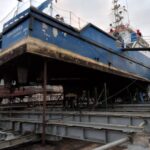Stretching at 14.5 km connecting Puttalam to Colombo via Negombo lies one of Sri Lanka’s greatest arteries – the Hamilton Canal named after a British Agent. This canal is also known as the Dutch Canal mainly because it was a primary method used by them to transport spices.
However, it was neither the Dutch nor the British that first made use of this canal. A couple of centuries before the Dutch occupied Sri Lanka, King Vira Parakramabahu VIII (Kingdom of Kotte) used the Negombo lagoon as the main seaport to trade commodities such as cinnamon. He was the one who first began constructing this canal. Later, when the Dutch established Colombo as their capital, they tried to grow paddy in the Muthurajawela Marshes and soon learnt that the field was drowned with seawater when the tides changed. That is what mainly prompted them to develop the old system of waterways; serving two purposes. One was to siphon the saltwater from their paddy fields and the other was as a method of transportation to carry cinnamon to their seaports in Negombo.
Later, the British – between 1802 and 1804 – started building a new canal from Colombo to Negombo. This was named after Gavin Hamilton who was the British Government Agent of Revenue and Commerce.
Dead Fish and Garbage
In April 2019, the general public and several government officials made a complaint to the National Aquatic Resources Research and Development Agency (NARA) about an incident that caused serious concern – a countless number of dead fish floating in the canal, mixed in with garbage. A report released by NARA on this incident stated that the main cause was the garbage that was dumped into the canal via the Muthurajawela Waste Dumping Site.
“The Muthurajawela waste dumping site has a total area of 20 hectares with buildings and started in 2017 after the incident of Meethotamulla. Furthermore, the area receives only sorted garbage with a total of 750 tonnes with 250 tonnes of degradable garbage. The leachate of the waste dumping site accumulates at the bottom of the landfill and percolates through the soil and overflowing to the canal nearby. There was a leachate filtering system before connecting to the canal and it was not working at the time of observation and leachate directly entering to the canal without filtering,” the report stated.
A Conduit for Garbage
Pollution, specifically plastic pollution is a major threat to the marine ecosystem. This threat considerably increases when the garbage keeps getting dumped into the ocean. Data from the Ministry of Environment suggests approximately 400 MT of plastic waste is generated daily within Sri Lanka and most of it gets dumped in our ocean. The Hamilton Canal, which was used in the past to transport spices, today transports great danger to marine life, through no fault of its own.
Many of Sri Lanka’s canals are adversely affecting marine life because of the amount of garbage that is passed on to the ocean.
Marine Environment Protection Authority General Manager Dr P.B. Terney Pradeep Kumara in an interview with Daily FT said “From all the waste that reaches the ocean, only 30% comes back to shore, which means 70% remains at sea. This means preventing plastic waste from reaching the ocean is a very crucial step of marine environment protection.”
Solutions for the Future

In the past, the Hamilton canal was used to help mankind. At present, the canal is filled with garbage and plastic debris, causing a major threat to marine life. For the future, it is important to come up with a strategy to protect the marine ecosystem along with our ocean. As the saying goes, “Prevention is better than cure”, the best method is to prevent the garbage from entering the ocean in the first place.
This is where the need for a trash trap comes in.
The most basic of a trash trap will generally float in waterways in order to capture garbage before it flows farther downstream by using the current to guide debris into the trap. This will prevent the garbage from reaching the ocean.
Oceanlust has partnered with a number of other interested parties in order to build a trash trap in the Hamilton Canal. For more information on this follow us on Youtube and Facebook.







Leave a Reply